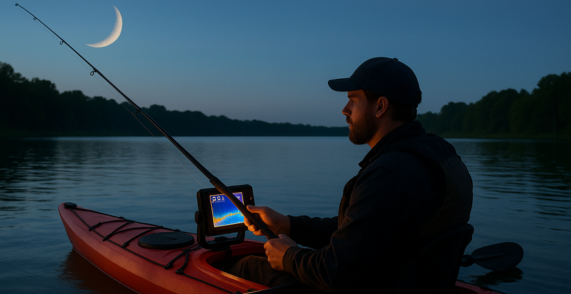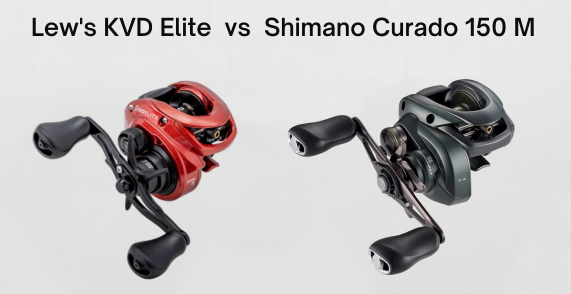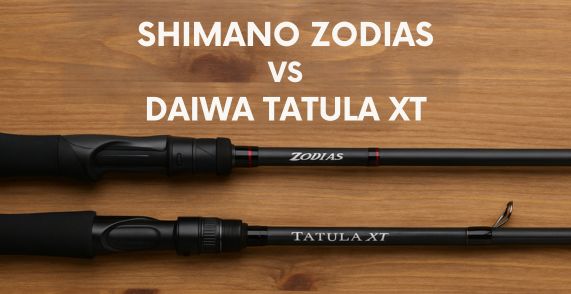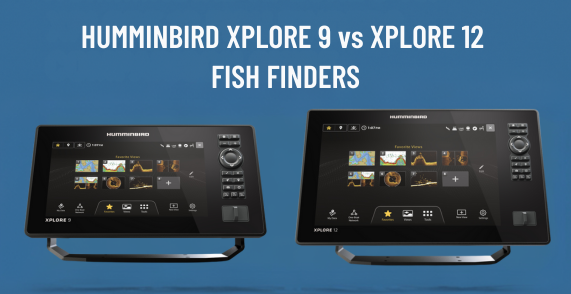In This Post
- 1 Key Takeaways:
- 2 Why Fish Bite Better After Dark: The Night Fishing Advantage
- 3 Essential Fish Finder Technology for Nocturnal Success
- 4 Setting Up Your Kayak for Night Fishing
- 5 Power Systems and Battery Management
- 6 Fish Finder and Transducer Mounting Solutions
- 7 Navigating in Darkness: GPS and Waypoint Management
- 8 Target Species and Tactical Approaches
- 9 Choosing the Right Fish Finder for Night Use
- 10 Master the Night: Safer Fishing with Greater Results
Key Takeaways:
- Night fishing from a kayak produces trophy catches as fish are more relaxed and feed actively in darkness with less pressure from other anglers
- CHIRP sonar technology offers superior target separation in dark conditions, helping you distinguish individual fish and structure when visibility is poor
- Coast Guard regulations require kayaks to display a 360-degree visible white light, but additional functional lighting enhances both safety and fishing success
- GPS functionality becomes critical when fishing at night as visual landmarks disappear, allowing you to mark productive spots and navigate safely.
Why Fish Bite Better After Dark: The Night Fishing Advantage
Night fishing from a kayak opens up exceptional opportunities for trophy catches that often elude daytime anglers. As darkness falls, fish become noticeably more relaxed and feed with greater confidence.
Without the bright sun penetrating the water and with reduced boat traffic, even pressured fish let their guard down. This natural phenomenon creates the perfect scenario for landing that fish of a lifetime.
The advantages extend beyond just fish behavior. Fishing Zenith explains that water temperatures typically drop after sunset, creating more comfortable conditions for both fish and anglers.
This temperature change triggers increased feeding activity, particularly in summer months when daytime heat can suppress fish movement. Additionally, the cover of darkness gives stealthy kayak anglers a significant advantage over larger, noisier motorized boats.
Essential Fish Finder Technology for Nocturnal Success
1. CHIRP Sonar: Superior Target Separation in Darkness
When fishing after dark, your eyes become virtually useless for spotting underwater structure or fish movement. This is where CHIRP sonar (Compressed High Intensity Radiated Pulse) becomes invaluable.
Unlike traditional sonar that sends single-frequency pulses, CHIRP technology transmits continuous sweeps of frequencies that provide remarkably detailed underwater images.
The benefits of CHIRP for night fishing are substantial:
- Target separation less than two inches (allowing you to distinguish individual fish in schools)
- Enhanced ability to differentiate between fish and structure (critical when you can’t visually verify what’s below)
- Improved bottom tracking at higher speeds and depths
- Better performance in noisy water conditions
Popular CHIRP-enabled fish finders for kayaks include the affordable Garmin Striker Vivid 4cv ($329), the more advanced Garmin Echomap UHD2 93sv ($999), various Lowrance Eagle series models, and the feature-rich Humminbird Helix 7 CHIRP with side-imaging capabilities.
2. Display Features Optimized for Low Light
The fish finder’s display quality becomes even more critical during night fishing. Key features to prioritize include:
- High-resolution color displays with adjustable backlighting
- Night mode color palettes that preserve your natural night vision
- Glare-reducing screen coatings or attachable visors
- Waterproof touchscreens that remain responsive when wet
The ability to quickly dim your screen is particularly important, as an overly bright display not only drains your battery faster but also compromises your night vision and can attract unwanted insects.
3. Interpreting Sonar Returns When You Can’t See the Water
Without visual cues to confirm what’s below, interpreting sonar returns becomes an art form during night fishing. The key is understanding how to read shadows and arches on your display.
Fish typically appear as arcs on traditional sonar as they move through the cone-shaped beam, with larger arcs indicating bigger fish. Structure creates more solid returns with distinctive shadows behind them.
When fishing in darkness, pay particular attention to:
- Fish positioning relative to structure (predators often hold along edges)
- Bait schools (usually appearing as clusters of smaller returns)
- Bottom composition changes (transitions from hard to soft bottom often concentrate fish)
- Thermoclines (temperature boundaries where fish frequently congregate)
Setting Up Your Kayak for Night Fishing
Coast Guard regulations require kayaks to display an all-around white light visible from 360 degrees. While a handheld flashlight technically satisfies this requirement, it’s far from ideal.
The safest approach is mounting a pole light at least 4 feet above the water on your kayak’s stern. This height ensures maximum visibility to other vessels.
Avoid using red/green navigation lights unless your kayak is motorized, as these signal a powered vessel and can confuse other boaters about your vessel type and direction of travel. For enhanced visibility, apply reflective tape to your paddle blades, PFD, and kayak hull.
2. Functional Lighting for Tackle and Fish Handling
Beyond navigation lights, functional lighting makes night fishing more productive and comfortable. Consider these options:
- Deck-mounted LED strip lights for tackle access and fish handling
- Red-light headlamp for close-up work without compromising night vision
- Waterproof flashlight as backup and for signaling if needed
- Glow-in-the-dark accessories for frequently used items
Strategically position lights to minimize glare on your fish finder display. Many anglers install lights under gunwales or use indirect lighting to maintain night vision while still illuminating essential areas.
3. Reflective Elements for Enhanced Visibility
In addition to active lighting, passive reflective elements significantly improve safety. Apply marine-grade reflective tape to:
- Paddle blades (creates a highly visible flash when paddling)
- PFD shoulders and back (improves visibility if you end up in the water)
- Kayak bow and stern (increases visibility from all angles)
- Essential gear and equipment (makes items easier to find)
Power Systems and Battery Management
1. Calculating Your Power Needs for All-Night Fishing
Most kayak fish finders operate on 12V systems, with power requirements varying significantly by model. To calculate how long your battery will last, use this simple formula: Battery Life (hours) = Battery Capacity (Ah) / Power Consumption (A).
Typical power consumption ranges:
- Basic fish finder: 0.23-0.8 amps
- Advanced units with GPS: 2-5 amps
- LED lighting: 0.1-1.6 amps
- Trolling motor (if used): 30-55 amps
For night fishing trips, consider these battery capacity recommendations:
- Short trips (2-4 hours): 20-40Ah battery
- Full night fishing (6-10 hours): 50-100Ah battery
- Electronics-only setup: 10-20Ah usually sufficient
2. Lithium vs. Lead-Acid: The Weight and Performance Tradeoff
While traditional lead-acid batteries are affordable, their weight (up to 50 pounds) makes them impractical for most kayak applications. Lithium batteries, particularly LiFePO4 (lithium iron phosphate), offer significant advantages for night fishing:
- Substantially lighter weight (5-6 pounds vs. 50 pounds for equivalent power)
- Stable voltage output throughout discharge cycle (maintains fish finder performance)
- Longer cycle life (3,000-5,000 cycles vs. 300-500 for lead-acid)
- Better performance in extreme temperatures
- No risk of acid leakage
The initial cost of lithium batteries is higher, but their extended lifespan and superior performance make them the preferred choice for serious kayak anglers, especially for night fishing when power reliability is critical.
3. Extending Battery Life in the Field
To maximize your time on the water, implement these power-saving strategies:
- Dim your fish finder screen to the minimum usable brightness
- Turn off unnecessary sonar features when not needed
- Use targeted lighting rather than full illumination
- Carry a backup power bank for emergency use
- Consider a portable solar charger for multi-day trips
Fish Finder and Transducer Mounting Solutions
1. Track-Mounted Display Options
Modern kayak fish finder installation has evolved to minimize permanent modifications. Track-mounted systems offer flexibility and clean installation:
- RAILBLAZA systems provide no-drill mounting with quick removal capability
- YakAttack mounts integrate battery and display mounting in a single system
- RAM mounts feature adjustable arms for optimal viewing angles
Position your display where it’s easily visible at night without requiring you to shift position or shine additional light on it. Many anglers mount displays just forward of the seating area, angled slightly up for better viewing in a seated position.
2. Transducer Installation Methods
The transducer is your fish finder’s underwater eye, and proper installation is crucial for accurate readings. Popular mounting options include:
- Scupper mounts that utilize existing drain holes (simple installation, good performance)
- Through-hull installations (permanent but provides optimal performance)
- In-hull mounting using duct seal (works through plastic hulls, no external components)
- Arm mounts that can be retracted when not in use
For night fishing, reliability is particularly important, so avoid temporary attachments like suction cups that might fail in darkness when repairs are more difficult.
3. Cable Management and Waterproofing
Proper cable management not only creates a cleaner installation but also protects your investment. Run cables inside the hull when possible, using watertight deck fittings where cables must pass through the kayak. Use marine-grade heat-shrink connectors and waterproof junction boxes for all electrical connections.
Secure cables along natural channels in the kayak to prevent snagging, and include enough slack to allow for component adjustment without straining connections. Label all cables at both ends for easier troubleshooting if issues arise during a night trip.
1. Color-Coded Waypoint Systems for Different Fishing Scenarios
GPS functionality becomes crucial during night fishing when visual landmarks disappear. Develop a consistent waypoint marking system to maximize efficiency:
- Red waypoints for structure spots (ledges, rockpiles)
- Blue waypoints for deep holes and channels
- Green waypoints for vegetation edges
- Yellow waypoints for current breaks
- Purple waypoints for night-specific hotspots
This color-coding system allows you to quickly identify the type of fishing opportunity each waypoint represents, even in darkness. Many GPS-enabled fish finders allow you to customize icons as well, adding another layer of visual organization to your waypoints.
2. Detailed Naming Conventions for Future Success
Beyond colors, develop a consistent waypoint naming convention that encodes additional information. An effective system might include:
- Location identifier (“DOCK,” “BRIDGE,” “POINT”)
- Depth indicator (“12FT,” “6-8FT”)
- Target species (“LMB” for largemouth bass, “CAT” for catfish)
- Tidal phase if applicable (“HW+1” for 1 hour after high water)
For example, a waypoint named “DOCK_6FT_LMB_HW+1” tells you it’s a dock structure in 6 feet of water where you’ve caught largemouth bass one hour after high tide.
This detailed approach ensures you can return to productive areas under similar conditions, a crucial advantage when fishing patterns change throughout the night.
Target Species and Tactical Approaches
1. Prime Nocturnal Freshwater Species
Many freshwater species become more active after dark. These top night-time targets each require specific approaches:
- Bass (Largemouth & Smallmouth): Active at night, often moving shallow to feed. Target them with slow-rolled spinnerbaits, black buzzbaits, or large soft plastics around lighted structures.
- Catfish (Channel, Blue, Flathead): Classic nocturnal feeders that rely on scent and vibration. Use fresh cut bait, live bait, or stink baits fished along channel edges or near structure.
- Walleye: Their reflective eyes give them a significant night-vision advantage. Target them with minnow-imitating lures or jigs tipped with nightcrawlers near current breaks.
- Crappie: Often suspend under docks with lights or around bridge pilings at night. Small jigs or minnows under a light source can be extremely productive.
2. Saltwater Predators That Hunt After Dark
Inshore saltwater fishing often peaks after sunset as predators move shallow to feed:
- Snook: Masters of the night ambush, they patrol docks, bridges, and lighted areas. Slow-roll swimbaits or fish live bait along shadow lines.
- Redfish: Feed aggressively after dark, often tailing in shallow water. Gold spoons, scented soft plastics, and cut bait are all effective.
- Flounder: True nocturnal ambush predators that lie in wait on bottom. Slow-dragged soft plastics or live bait bumped along the bottom works best.
- Tarpon: Often roll at the surface near lighted structures at night. Live bait under a float or large swim baits can entice these giants.
3. Light-Line Fishing: Exploiting the Shadow Edge
One of the most effective night fishing tactics involves positioning yourself to cast into the boundary between light and shadow. This “shadow edge” is where predatory fish wait to ambush baitfish that wander out of the light.
The strategy is simple but devastatingly effective:
- Position your kayak upwind or up-current from a light source (dock light, bridge light, etc.)
- Cast beyond the light-shadow boundary
- Retrieve your lure from darkness into light, then back into darkness
- Pay special attention to the moment your lure crosses from light to shadow
This mimics the vulnerable moment when baitfish leave the protection of light, triggering predatory strikes. Your fish finder helps identify these light-shadow transitions underwater even when they’re not visible from the surface.
4. Sound and Vibration: When Sight Isn’t the Primary Sense
In darkness, fish rely more heavily on their lateral line system to detect prey. This shifts the effectiveness of different lure types:
- Vibrating lures: Chatterbaits, bladed jigs, and spinnerbaits create distinct vibrations fish can sense at distance
- Rattling baits: Lures with internal rattles create sound signatures that draw attention in dark conditions
- Surface disturbances: Topwater lures that create sound and surface commotion can trigger explosive strikes
- Scented options: Soft plastics with added scent provide additional sensory cues
Additionally, slow your retrieve speed at night. Many species become less aggressive in darkness and prefer an easier target. This slower presentation keeps your lure in the strike zone longer and gives fish more opportunity to locate it through non-visual senses.
Choosing the Right Fish Finder for Night Use
1. Humminbird PiranhaMax: Simple Interface with Brightness Challenges
The Humminbird PiranhaMax series represents an entry-level, straightforward option with dual-beam sonar capability. Its primary advantages include:
- Simple, user-friendly interface with minimal settings to adjust
- Bright, clear display that’s easy to see
- Affordable price point for beginners
However, this model has a significant drawback for night fishing: its backlight is extremely bright on default settings and cannot be saved at a lower level.
This means you’ll need to adjust brightness every time you turn it on, and even at its lowest setting, it may still be brighter than ideal for preserving night vision.
2. Lowrance Hook Reveal: Quick-Dim Feature for Night Vision Preservation
The Lowrance Hook Reveal series offers a compelling feature set for night anglers:
- FishReveal technology overlays colored fish arches onto downscan images for easier identification
- Quick-touch backlight adjustment via power button allows instant dimming
- Multiple sonar frequency options for different depths and conditions
The quick-dim feature is particularly valuable for night fishing, as it allows you to temporarily reduce screen brightness when scanning the water, then return to normal brightness when interpreting returns.
3. Portable Options: Garmin Striker Cast & Deeper Smart Sonar
Portable, castable sonar units offer unique advantages for night kayak fishing:
- Minimal installation requirements (no mounting, drilling, or wiring)
- Smartphone connectivity provides familiar interface
- Easy transfer between different watercraft
The Garmin Striker Cast is lightweight with Bluetooth connectivity and scanning depths up to 150 feet. The Deeper Smart Sonar offers greater scanning depth (up to 260 feet) and Wi-Fi connectivity, though it’s slightly heavier.
The primary disadvantage for night use is relying on your smartphone screen, which can be a source of glare and may attract insects. Using a red screen filter app can help mitigate these issues.
4. Garmin Echomap: Premium Features with Night-Friendly Color Palettes
For serious night anglers, the Garmin Echomap series offers premium capabilities:
- Multiple color palette options specifically designed for different lighting conditions
- Combination of touchscreen and button controls (buttons are easier to use when wet)
- Advanced mapping and sonar capabilities including side-imaging
- User-customizable display layouts
The ability to switch between different color palettes is particularly valuable for night fishing, as certain colors (like red and green) preserve night vision better than the bright blues and whites of standard palettes.
Master the Night: Safer Fishing with Greater Results
Night fishing from a kayak equipped with the right fish finder technology opens up an entirely new dimension to your angling experience.
The combination of advanced sonar, proper lighting, reliable power systems, and night-specific tactics creates opportunities for exceptional catches that simply aren’t available during daylight hours.
By understanding how fish behavior changes after dark and using technology to compensate for limited visibility, you can safely and confidently pursue trophy fish while most anglers are at home.
From detecting subtle bottom changes to navigating safely in darkness, your fish finder becomes the most important tool in your nocturnal arsenal.







